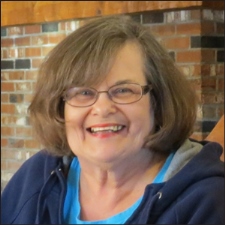 “I got keratoconus as a wedding present,” Joanne Ciesluk says with a characteristic long laugh.
“I got keratoconus as a wedding present,” Joanne Ciesluk says with a characteristic long laugh.
She was 35 and had been married for just two months. Suddenly, my contact lenses didn’t work. And my glasses didn’t work. And I said, “What the heck is going on with this? I went to the eye doctor and was diagnosed with keratoconus,” she says. “I asked my new husband, “Do you want me anyway? He said, “Oh yeah, we already tied the knot, so I’ll keep you.”
While Ciesluk had worn glasses then contacts for nearsightedness since she was a child, she’d always considered her vision to be good. But the clinical nurse was forced to make an abrupt career change: “All of a sudden, I couldn’t tell an 8 from a 3 from a 5. I was dispensing medications, and I realized, ‘Oh my gosh, I can’t do this.’ I switched to administrative nursing, because I knew I could still make an appreciable difference. It was a U-turn for my career, but it worked out very well. With keratoconus, you can’t plan on anything; you just have to go with the flow,” she says.
Treatments and Procedures
The Massachusetts native underwent her first corneal transplant, in her right eye, at age 65. She has since had a transplant in her left eye, as well as cataract surgery and YAG laser procedures.
“When I was diagnosed 35 years ago, nobody knew what it was. For 25 years, everyone went, ‘Kerato-what???'” she says, adding that the only treatment option for her at the time was to stay in rigid gas-permeable lenses as long as possible and wait until it was time for a transplant. “By the time all the new treatments came around, it was too late for me. My cones were too steep, the machines couldn’t even read my topography. I am so happy for the people today who have treatment choices.”
Ciesluk has an infectiously positive attitude about life; to her, KC is “just a bump in the road. I have a great sense of humor about it. It’s not fatal. You don’t die. It’s just a pain in the butt. You find ways around things. I’ve never, ever felt like a victim of keratoconus. It’s just like, ‘Eh, that’s the way my eyes are,’ and other people have other stuff,” she says.
With Rose-K contact lenses and bifocals, she is now able to drive during the day. Thanks to all the procedures, vision in her right eye is the best it’s been in years. And, with the help of a magnifier, she is thrilled to be able to play the piano and crochet again.
Finding NKCF [former keratoconus program of DEF]
“I came across the *National Keratoconus Foundation (NKCF) accidentally, as I was poking around the computer for information about keratoconus,” Ciesluk says. “I found the website and thought, ‘There’s something out there for people like me! This is amazing!’ It was wonderful. It gave me something to show people in my family, so they could understand it, too.
“There is always something new, and I rely on the website for the educational aspect to be able to see a video of a corneal transplant, to be able to have an explanation of what the different lenses are. And I often print out things from the site to bring to my doctor and say, ‘This is the latest and the greatest. Are you up to speed on this?'”
Now 71, Ciesluk has been an active participant in KC-Link, NKCF’s interactive e-mail group, since 2003. “I scan the e-mails, and I try to pump up people and make those who feel so flattened by KC feel enthusiastic,” she says. “I tell them: ‘There are great treatments now. The people on this board are fabulous. You’re going to find friends here.'”
“When I was having my first transplant, I found others on KC-Link who were having transplants at the same time. We supported each other, and we are still in touch,? she says. “Recently, someone posted to ask if she is the only one who wears glasses over her contact lenses. I was able to write back and say, ‘Nah, I do that, too.’ The woman wrote me a separate e-mail telling me that made a real difference to her.
“For me, KC-Link makes me feel there is a community out there for me. It makes me feel not-so-by-myself. It makes me feel there are people out there who understand, and they don’t go, ‘Kerato-what?'”
*The National Keratoconus Foundation became a program of the Gavin Herbert Eye Institute, UC Irvine in 2016. Go to www.nkcf.org for more information.

